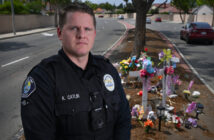Making a few dollars an hour sounds like the worst-paying job a person could have.
But as a little girl, Julie Romano thought her pay, and her job, were very exciting.
Romano was hired by her father, for $1 a page, to scan dozens of pages of phone numbers.
Her dad, a police officer at the time, hated reading the small print, and Romano had young eyes.
She used a ruler to go down, line by line, marking how often certain numbers called others, sorting and collecting the data, then reporting back to her dad.
Romano enjoyed it so much she probably would have done it for free, but the extra allowance was nice.
“I just loved it,” she said.
Working with her dad was her first taste of law enforcement, and while she was sold on the profession, she didn’t want to be out in the streets.
“I never had the desire to be a cop because I just didn’t think I had the strength to do it,” she said.
But Romano has one critical strength that is a major asset for the Huntington Beach Police Department — her love for data.
As the HBPD certified crime analyst, Romano’s work is credited with reducing crime and inspiring a more proactive police force.
She works on crime statistics, traffic analysis and also updates officers on the status of parolees.
“I’m sort of the parolee welcome wagon,” she said laughing. “I let officers know who’s new in the city each week and who to look out for.”
With crime statistics, Romano creates databases and uses mapping to alert officers of budding crime trends so police can focus their resources in certain geographic areas, called hot spots.
“I have databases for different things — DUIs, graffiti, burglaries — and those databases are intermingled,” she said. “I go through and map all the crime to see what’s high and what’s low.”
In one recent case, crime data analyzed by Romano helped police arrest several suspects burglarizing homes in Huntington Beach.
Her data also helped link the suspects to burglaries in other cities.
Police could not give specifics of the case because it is still under investigation, but the arrests illustrate usefulness of real-time crime data.
“We know how they hit, when they hit and what they targeted,” Romano said. “And that information helped us find them.”
The next step is using information to look to the future and predict trends so police officers can more strategically patrol the city.
This type of predictive analysis is called risk terrain modeling, and it is something Huntington Beach police are currently working on perfecting.
“Using hot spots can tell us where we should have been, but they don’t forecast the future,” Romano said.
Risk terrain maps will help police determine where certain crimes are more likely to occur so they can deploy resources more effectively.
All these efforts combined make for a safer city and a more efficient police force, Romano said.
“With this, you have the potential to get your crime rate down,” Romano said. “I am working to make us a more proactive police department.”
 Behind the Badge
Behind the Badge



